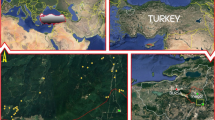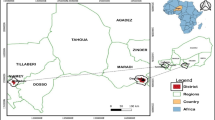Abstract
Oak decline is an expression describing death and drying up of oak trees. The present research evaluated the relationship between various geographical directions and altitude and some factors predisposing Persian oak (Quercus brantii Lindl.) decline, such as charcoal disease and oak wood boring insects in a 100 hectares area of the Shurabad forests in Lorestan Province of Iran. A 200 by 200 m sampling network was first designed on a regular-random (systematic) basis, and the trees were sampled from 1500-m2 circular plots. Information including hillside direction, altitude, infection site (on tree crown or on trunk), type of infection (charcoal disease or wood borers), crown vigor, and heights of the infection sites on the trees was recorded in each sample plot. Results indicated the significant relationships of infection type and severity with altitude, geographical direction, slope, and location of the sample plot at the significance level of 5%. Wood borers were the most common cause of infection. There was very little attack by charcoal disease in the study area. Most diseased trees were in the valley, in a northerly direction, at the 1101–1150 m elevation class and the 41–50% slope class. There were very few healthy trees in the study area, and most of them were on the ridges, in a southwesterly direction, at the 1151–1200 m altitude class and the 11–20% slope class.









Similar content being viewed by others
References
Afridoun M, Kalbi S, Fallah, A, Oladi, Jalilvand, H (2014) Identify affecting factors on degradation and decline of oak forests of Zagros. In: Proceedings of the 1st national conference on oak forests, 3–4 September 2014, Sanandj, Iran, pp 249–255 (In Persian)
Afshar M, Jahan Tab A, Afshar A (2014) Studding Oak species and effective factors on declining of it in Zagros forests. In: Proceedings of the 1st national conference on oak forests, 3–4 September 2014, Sanandj, Iran, pp 192–197 (In Persian)
Allen CD, Breshears DD (1998) Drought-induced shift of a forest–woodland ecotone: rapid landscape response to climate variation. Proc Natl Acad Sci 95(25):14839–14842
Amman GD (1973) Population changes of the mountain pine beetle in relation to elevation. Environ Entomol 2(4):541–548
Assareh MH (2005) Plant diversity in Iran. Publications of Research Institute of Forests and Rangelands, Tehran (In Persian)
Baccalá NB, Rosso PH, Havrylenko M (1998) Austrocedrus chilensis mortality in the Nahuel Huapi National Park (Argentina). For Ecol Manag 109(1–3):261–269
Bale C, Williams J, Charley J (1998) The impact of aspect on forest structure and floristics in Eastern Australian sites. For Ecol Manag 110(1):363–377
Barnes BV, Zak DR, Denton SR, Spurr SH (1997) Forest ecology, 4th edn. Wiley, New York
Batzer HO, Popp MP (1985) Forest succession following a spruce budworm outbreak in Minnesota. For Chron 61:75–80
Bendixsen DP, Hallgren SW, Frazier AE (2015) Stress factors associated with forest decline in xeric oak forests of south-central United States. For Ecol Manag 347:40-48
Brady C, Denman S, Krik S, Venter S, Rodriguez-Palenzuela P (2010) Description of Gibbsiella quercinecans associated with Actue Oak decline. Syst Appl Microbiol 33:444–450
Capretti P, Battisti A (2007) Water stress and insect defoliation promote the colonization of Quercus cerris by the fungus Biscogniauxia mediterranea. For Pathol 37:129–135
Day WR (1927) The oak mildew Microsphaera quercina (Schw.) Burrill and Armillaria mellea (Vahl) Quél. in relation to the dying back of the oak. Forestry 1:108–112
Denman S, Nathan B, Kirk S, Jeger M, Webber J (2014) A description of the symptoms of Acute Oak Decline in Britain and a comparative review on causes of similar disorders on oak in Europe. For: Int J For Res 87(4):535–551
Desprez-Loustau ML, Marçais B, Nageleisen LM, Piou D, Vannini A (2006) Interactive effects of drought and pathogens in forest trees. Ann For Sci 63(6):597–612
Ebrahimi Rostaghi M (2004) Forests of Iran (Semi-humid and semi-arid forests). Forests, range and watershed management organization. Publications of the Forest Department, Tehran (In Persian)
Ehrenfeld JG (1980) Understory response to canopy gaps of varying size in a mature oak forest. Bull Torrey Bot Club 107:29–41
Fajvan MA, Wood JM (1996) Stand structure and development after gypsy moth defoliation in the Appalachian Plateau. For Ecol Manage 89(1):79–88
Falck R (1918) Oak Decline in Lödderitz Forest District and in Westphalia. Zeitschrift für Forst- und Jagdwesen 50:123–132
Fettig CJ, Shea PJ, Borys RR (2005) Spatial and temporal distributions of four bark beetle species (Coleoptera: Scolytidae) along two elevational transects in the Sierra Nevada. Pan-Pac Entomol 81:6–19
Guarin A, Taylor AH (2005) Drought triggered tree mortality in mixed conifer forests in Yosemite National Park, California, USA. For Ecol Manag 218:229–244
Hansen EM (1996) Western balsam bark beetle, Dryocetes confusus Swaine, flight periodicity in northern Utah. Great Basin Natl 56:348–359
Hendry SJ, Lonsdale D, Boddy L (1998) Strip-cankering of beech (Fagus sylvatica): pathology and distribution of symptomatic trees. New Phytol 140:549–565
Hendry SJ, Boddy L, Lonsdale D (2002) Abiotic variables affect differential expression of latent infections in beech (Fagus sylvatica). New Phytol 155:449–460
Holland PG, Steyne DG (1975) Vegetation responses to latitudinal variations in slope angle and aspect. J Biogeogr 2:179–183
Hosseini A (2012) Infestation of forest trees to the borer beetle and its relation to habitat conditions in the Persian oak (Quercus brantii) in Ilam Province. Iran J For Range Protect Res 9(1):53–66 (In Persian)
Hosseinzadeh J, Azami A, Mohammadpour M (2015) Influence of topography on Brant`s oak decline in Meleh-Siah Forest, Ilam Province. Iran J For Poplar Res 23(1):190–197 (In Persian)
Jimenez JA, Lugo AE, Cintron G (1985) Tree mortality in mangrove forests. Biotropica 17(3):177–185
Jonášová M, Prach K (2004) Central-European Mountain spruce (Picea abies (L.) Karst.) forests: regeneration of tree species after a bark beetle outbreak. Ecol Eng 23:15–27
Karami J, Kavosi MR, Babanezhad M (2015) Assessing the relationship between some environmental variables and spread of charcoal disease on chestnut-leaved oak (Quercus castaneifolia CA Mey). Iran J For Range Protect Res 13(1):34–35 (In Persian)
Kaufmann MR, Ryan MG (1986) Physiographic, stand, and environmental effects on individual tree growth and growth efficiency in subalpine forests. Tree Physiol 2(1-2-3):47–59
Keshavarz K, Mirabolfathi M, Hasanpour B, Khoshnod-Mansorkhani Kh (2014). Identification and distribution of oak charcoal disease in Kohgiluyeh and Boyer-Ahmad Province. In: Proceedings of the 1st national conference on oak forests, 3–4 September 2014, Sanandj, Iran, pp 147–150 (In Persian)
Klimesch J (1924) Eichensterben in Jugoslavien. Allgemeine Forst-und Jagdzeitung 46:271–273
Klutsch JG, Negrón JF, Costello SL, Rhoades CC, West DR, Popp J, Caissie R (2009) Stand characteristics and downed woody debris accumulations associated with a mountain pine beetle (Dendroctonus ponderosae Hopkins) outbreak in Colorado. For Ecol Manag 258:641–649
Linaldeddu BT, Sirca C, Spano D, Franceschini A (2011) Variation of endophytic cork oak-associated fungal communities in relation to plant health and water stress. For Pathol 41:193–201
Mahdavi A, Mirzaei Zadeh V, Niknezhad M, Karami O (2015) Assessment and prediction of oak trees decline using logistic regression model (Case study: Bivareh forest, Malekshahi-Ilam). Iran J For Range Protect Res 13(1):20–23 (In Persian)
Martin J, Cabezas J, Buyolo T, Paton D (2005) The relationship between Cebambyx spp. Damage and subsequent Biscogniauxia mediterranea infection on Quercus suber forests. For Ecol Manage 216:166–174
Marvi-Mohadjer MR (2005) Silviculture. University of Tehran Press, Tehran (In Persian)
Mattson WJ, Haack RA (1987) The role of drought in outbreaks of plant-eating insects. Bioscience 37(2):110–118
Mirabolfathi M (2012) Outbreak of charcoal disease on Quercus Spp. and Zelkova carpinifolia trees in forests of Zagros and Alborz mountain of Iran. Iran J Plant Pathol 49(2):257–263 (In Persian)
Negrón JF, McMillin JD, Anhold JA, Coulson D (2009) Bark beetle-caused mortality in a drought-affected ponderosa pine landscape in Arizona, USA. For Ecol Manag 257(4):1353–1362
Nugent LK, Sihanonth P, Thienhirun S, Whalley AJS (2005) Biscogniauxia: a genus of latent invaders. Mycologist 19:40–43
Orwig DA, Foster DR (1998) Forest response to the introduced hemlock woolly adelgid in southern New England, USA. J Torrey Bot Soc 125:60–73
Osmaston LS (1927) Mortality among oak. Q J For 21:28–30
Robinson RL (1927) Mortality among oak. Q J For 21:25–27
Sartwell C (1971) Thinning ponderosa pine to prevent outbreaks of mountain pine beetle. In: Baumgartner DM (ed), Proceedings, precommercial thinnings of coastal and intermountain forests in the Pacific Northwest, cooperative extension service and department of forestry and range management, Washington State University, Pullman, WA, pp 41–52
Sartwell C, Stevens RE (1975) Mountain pine beetle in ponderosa pine: prospects for Silvicultural control in second growth stands. J For 73:136–140
Stephenson NL (1990) Climatic control of vegetation distribution: the role of water balance. Am Nat 135:649–670
Tavakoli M, Khaghani Nia S, Pirozi F (2014) Introducing the Agriopis beschkovi Ganev, 1987 (Geometridae: Ennominae). In: Proceedings of the 1st national conference on oak forests, 3–4 September 2014, Sanandj, Iran, pp 159–162 (In Persian)
Vannini A, Biocca M, Paparatti B (1996) Contributo alla conoscenza del ciclo biologico di Hypoxylon mediterraneum su Quercus cerris. Inf Fitopatol 46:53–55
Yossifovitch M (1926) The decline of oak (Quercus pedunculata Ehrh.) in the forests of Slavonia (Yugoslavia). Revue des Eaux et Forêts 6:288–291
Zarrabi M, Tavakoli M, Tayebi S, Zarabi S (2014) The last situation of drying up and oak trees decline phenomenon in Lorestan Province. In: Proceedings of the 1st national conference on oak forests, 3–4 September 2014, Sanandj, Iran, pp 256–259 (In Persian)
Acknowledgements
This paper has been extracted from a research project which financially supported by Urmia university, Iran. We would like to thank the Agriculture and Natural Resources Research Centre of Lorestan for the assistant to data collecting.
Author information
Authors and Affiliations
Corresponding author
Additional information
Editorial responsibility: S. R. Sabbagh-Yazdi.
Rights and permissions
About this article
Cite this article
Zargaran, M.R., Goudarzi, N., Banj Shafiei, A. et al. The role of charcoal disease and wood borers on Quercus brantii Lindl. decline under different physiographical conditions. Int. J. Environ. Sci. Technol. 16, 5797–5806 (2019). https://doi.org/10.1007/s13762-018-1955-9
Received:
Revised:
Accepted:
Published:
Issue Date:
DOI: https://doi.org/10.1007/s13762-018-1955-9




